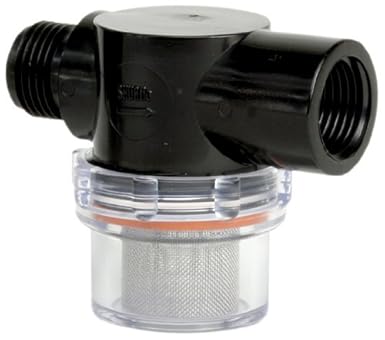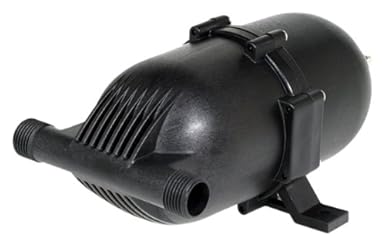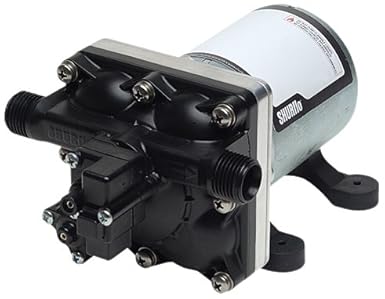
 First, we need to get the water into the house. On my property we will
First, we need to get the water into the house. On my property we willbe using a gravity fed water system, but I didn't want to limit myself so I chose a multi-port outlet that allows for hooking up to city water as well. I also chose one that has a locking lid to prevent introduction of anything that shouldn't be in the water system by those who have less than honorable means. Paranoid maybe, but I figure it is nice to take some precautions as I will be living in the boonies.
 The water inlet will connect by PEX to a potable water storage tank. I chose to get a 35 gallon freshwater tank even though I originally wanted a larger tank, but since I want it to fit under the counter in the kitchen, out of the way, I had to go with dimension that would work. That meant 35 gallons was the largest I could fit. The tank is a one-piece construction with both male and female outlets.
The water inlet will connect by PEX to a potable water storage tank. I chose to get a 35 gallon freshwater tank even though I originally wanted a larger tank, but since I want it to fit under the counter in the kitchen, out of the way, I had to go with dimension that would work. That meant 35 gallons was the largest I could fit. The tank is a one-piece construction with both male and female outlets.  Between the water tank and the pump is an in-line filter that allows me to catch sediment and debris before it enters the pump. I may get a second one to go between where the water comes in and before it enters the water tank just to be extra careful. This way stuff that shouldn't won't get deposited in my tank to begin with. It is just a simple filter with a fine mesh screen to catch particles. You simply unscrew the reservoir every so often and empty it out.
Between the water tank and the pump is an in-line filter that allows me to catch sediment and debris before it enters the pump. I may get a second one to go between where the water comes in and before it enters the water tank just to be extra careful. This way stuff that shouldn't won't get deposited in my tank to begin with. It is just a simple filter with a fine mesh screen to catch particles. You simply unscrew the reservoir every so often and empty it out.  The next piece is really optional, but I felt would it be worth the investment. It is an accumulator tank. An accumulator tank is pre-pressurized to smooth out water faucet pulsations and to reduce pump cycling. This helps to keep the water pressure consistent and the pump itself cool. It will help reduce the noisiness of the water pump and will help extend the life of the pump. I am also told that it will reduce the amount of batter power that is used to run the pump as well.
The next piece is really optional, but I felt would it be worth the investment. It is an accumulator tank. An accumulator tank is pre-pressurized to smooth out water faucet pulsations and to reduce pump cycling. This helps to keep the water pressure consistent and the pump itself cool. It will help reduce the noisiness of the water pump and will help extend the life of the pump. I am also told that it will reduce the amount of batter power that is used to run the pump as well. PEX line then connects from the accumulator to the water pump. The tiny house water system is similar to an RV water system. A 12 volt pump is activated when a faucet is turned on and supplies water pressure for a steady flow. SurFlo is the brand I chose because they have an excellent reputation. I purchased the Shurflo 4008-101-E65 3.9 Revolution Water Pump. The specs on this are:
PEX line then connects from the accumulator to the water pump. The tiny house water system is similar to an RV water system. A 12 volt pump is activated when a faucet is turned on and supplies water pressure for a steady flow. SurFlo is the brand I chose because they have an excellent reputation. I purchased the Shurflo 4008-101-E65 3.9 Revolution Water Pump. The specs on this are:- 12 VDC, 3.0 GPM, 55 PSI, and 7.5 Amps
- Self-priming water pump with internal bypass-low cycling
- Operates quietly and thermally protected
- This pump can run dry without damage and contains a built-in check valve
- Dry primes to 6 vertical feet and comes with a 2 Year Warranty
PEX line will run from the accumulator to the faucets as cold water and into the water heater to produce hot water. I chose an Energy Star rated propane water heater. I purchased it on Ebay because I found the best price there. This is a tankless, on-demand water heater which means no water is stored that must maintain a certain temperature. Water is instantly heated as it is run through the heater, only after a hot water faucet is opened. It has a fairly small footprint and hangs on the wall, so it doesn't use up valuable real estate in my tiny house.
PEX line is my piping of choice for this project because PEX tubing can be color-coded for hot and cold water, is easy to curve without having a lot of bends, is easy to repair, and doesn't require glues or solder. The PEX piping expands and contracts a little to help prevent pipes from bursting. One drawback is that a special tool, called a PEX Crimper, is required to make the connections, but my BF found one at a rummage sale for just $30. You can find a PEX crimping tool in the plumbing supplies section of your home improvement store. Some places actually rent the tool so, if you don't want to own it, that may be an option for you. Better yet, ask around about the tool with your friends. Maybe one of them has one you can borrow, and if they have experience, maybe they will help you when it comes time to plumb your tiny house. If you are concerned about your ability to install the water system and connect it to the electrical system, you may want to buy all the parts and just hire someone to come do the installation for you.
Planning carefully, using quality materials, and installing and maintaining properly, the water system in a tiny house should work flawlessly for many years. Is your water system similar? Have any suggestions for other tiny house owners who are contemplating their water system? Share about your system below.



Thanks for sharing awesome post, I bookmarked this blog further more information.
ReplyDeleteWater well system
According to Consumer Reports, the eSpring filter is able to filter water more quickly than most competitors, and the replacement cartridge can last for an entire year, as opposed to other units that need replaced every 6 months. The filter has electronic monitoring and a display so you know how much capacity is left and its UV light only switches on when it is running water to be dispensed, which keeps power consumption to a minimum. http://tbreviews.com/top-6-best-reverse-osmosis-system-reviews/
ReplyDeleteI will have to check that one out. Thanks for sharing.
DeleteHi Karin, great thread here. Not too many people get into plumbing specifics for DIYers. How long have you been using this system? Is there anything you would change? What is the orientation/positioning of all of your equipment? For example, what's next to what, above/below etc.? I'd love to see the system finished.
ReplyDeleteHow is your hot water heater, and which brand did you get? Also, what climate are you in?
ReplyDeleteYes I have the same question? is it propane heated or electrical? Great post by the way
DeleteThis is SUCH a helpful pst Karin, thank you! How much did the entire system cost you?
ReplyDeletehello there im an engineering student and have been assigned a project about tiny houses... im wondering about how much it ran you in total to this plumbing project?
ReplyDeletePlumbing came in around $3500 including pipe, well pump, water heater, pressure tank, etc.
DeleteHot water works great. I use a Siemens model. I live in Oklahoma. Highs in the 90's on average and cold down to 0 degrees. Hope this helps!
ReplyDeletethanks
ReplyDeleteIt is upto the owner of the house to keep a look out for some of the telltale symptoms of water leaks around the house. Like the sound of water flowing, even when no tap is turned on, ridiculously high water bill can indicate leaks, new cracks in the walls and floor, wet/ moist carpet and water patcheson the wall are all symptoms of a defective water line.
ReplyDeleteWilliams Inc